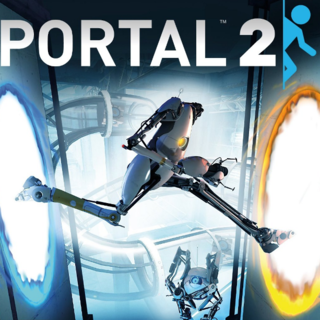If you loved this series' quirky debut cameo in The Orange Box, you'll undoubtedly love its equally charming second act.
Perhaps because the little gem was so unexpected, almost as if thrown in as an after-thought, it was truly a phenomenon and garnered volumes of critical acclaim. Personally, I found it to be as creative, charming, and memorable as any gaming experience I've enjoyed in this generation.
After Portal's success, a sequel became inevitable. And thankfully, Portal 2 does not disappoint -- it builds upon the solid foundation of the original game but expands its depth in many ways, unveiling important new story aspects of the universe while also multiplying the complexity and variety of gameplay through new puzzle elements.
In Portal, the central concept was navigating rooms using a portal gun that would allow instantaneous transport from one place to another. (For example, you could open up a portal on the wall and then set an exit portal on the ceiling. When you walked through the entrance portal, you would come out of the exit portal.) While moving through portals, your momentum was conserved, which allowed you to launch yourself by falling into an entrance portal and then setting the exit portal to project you to a desired location.
In Portal 2, the game retains the excellent and inventive puzzles of its predecessor, which mostly involved finding places to set your portals and figuring out how to use your momentum to get yourself to a hard-to-reach location. But the game adds new wrinkles to the formula by introducing some really fun elements to play with, including light bridges (energy planes upon which you can walk), funnels (energy columns which negate the effect of gravity and can move you across gaps), and mobility gels (goopy substances that make surfaces bouncy, or allow you to run faster). Suffice it to say that the possible combinations make for more difficult and more ingenious puzzles than the prior game.
The level of innovation peaks in the cooperative campaign. With two characters (and hence four portals) to work with, you should expect some truly fiendish puzzles. The cooperative campaign does not feel like a tack-on and is almost equal, in length and pleasure, to the single-player mode. It even features its own storyline which meshes in neatly with the single-player narrative.
Portal 2 represents the best of what a sequel can be: unlike other games that do not alter the game mechanics, or do so in a superficial and ultimately arbitrary way, Portal 2 introduces new elements that change the way you play and keep the game fresh. Though I suspect many fans would be perfectly content with more of the same, they should be ecstatic to experience the novel set-ups Valve has crafted, particularly in the cooperative campaign.
Thankfully, the series' story meshes perfectly with its gameplay, reintroducing old characters from the first game while also introducing new personalities that have become cult figures. (Just type "Wheatley" or "Space Core" into YouTube and you'll see what I mean.) And, of course, the commentary still contains Portal's trademark dark and ironic sense of humor.
This isn't to say the game is without flaws. Portal 2's single-player and cooperative experiences combine for perhaps 12-14 hours of gameplay, but there is very little replay value and no multiplayer. The lack of replay value, to be fair, isn't something that Valve could really fix: since the whole crux of the experience is solving puzzles, it's no fun to run through the game again when you already know all the solutions. And the lack of multiplayer is also an ineluctable problem, since this is a non-combat shooter. Nonetheless, the brevity of the experience recommends it more as a rental or a used purchase, rather than a permanent fixture in your collection.
Secondly, the single-player campaign suffers from a little unevenness. There are sections where, as the story progresses, the character is not solving a testing chamber but actually attempting to escape through the bowels of the facility. These moments do not achieve the same cleverness as the testing chamber sections, but thankfully are short enough that they do not mar the overall flow of the game.

